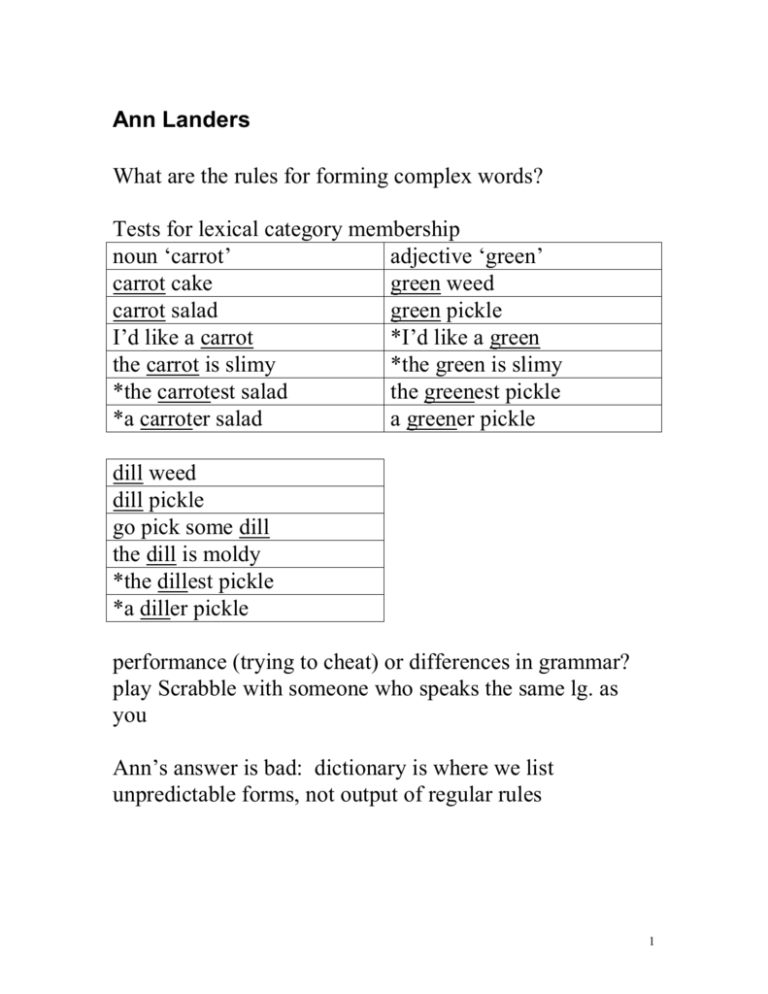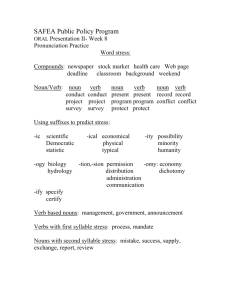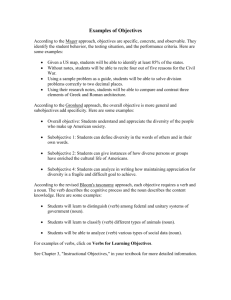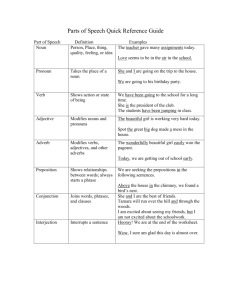Morphological competence
advertisement

Ann Landers
What are the rules for forming complex words?
Tests for lexical category membership
noun ‘carrot’
adjective ‘green’
carrot cake
green weed
carrot salad
green pickle
I’d like a carrot
*I’d like a green
the carrot is slimy
*the green is slimy
*the carrotest salad
the greenest pickle
*a carroter salad
a greener pickle
dill weed
dill pickle
go pick some dill
the dill is moldy
*the dillest pickle
*a diller pickle
performance (trying to cheat) or differences in grammar?
play Scrabble with someone who speaks the same lg. as
you
Ann’s answer is bad: dictionary is where we list
unpredictable forms, not output of regular rules
1
Morphological competence
An assumption: words exist
Speakers know (and linguists try to describe)
which words are possible
--which words can have -est or re- affixed to them?
--how can new words be added to a language?
PLAN: Prevent Los Angelization Now
Los Angelization: ‘process of causing to become like
Los Angeles’
properties of words: how can words be used in a
sentence?
“Kinko’s, the new way to office”
what complex words mean
E.g. unfoldable
unfolded’
‘not foldable’or ‘capable of being
‘not foldable’:
“This sweater is unfoldable; it’s too bulky.”
‘capable of being unfolded’:
2
“This origami figure is unfoldable; you just have to
take your time and do it carefully.”
3
Morphemes and signs
meaningpronunciation
in spoken languages, ‘morpheme’
in sign languages, ‘sign’
English
ASL
kind
under
unkind
redden
Los
Angelization
TEACH
TEACHER
1 morpheme: kind
1 morpheme: under
2 morphemes: kind, un2 morphemes: red, -en
3 morphemes: Los Angeles, -ize, -ation
1 sign (morpheme): TEACH
2 signs (morphemes): TEACH+ER
4
Morpheme syllable
cat
cats
carton
smarten
sycamore
hamamelidanthemum
# morphemes
1
2
1
2
1
1
# syllables
1
1
2
2
3
7
5
Free vs. bound morphemes
free: can stand alone as separate words
certain, able, carton, finch, pinch, sycamore
bound: cannot stand alone as separate words
/n/- negative (unkind); reverse (unfold)
/In/- negative
-/jz/ ‘to cause to become’
-/ejn/ ‘process of’
-/z/ plural
Arabic /l/- ‘the’
6
Affixation
Affix vs. root morphemes
Root morphemes: contributes the major component of a
word’s meaning
Roots typically have longer, more complex phonological
shapes than affixes.
stadium, sycamore, hamamelidanthemum
Roots typically are members of some lexical category.
7
Affix types
Prefixes--added to the left of a root:
/n/- (un) negative, Arabic /l/- ‘the’
Suffixes---added to the right of a root:
-/ajz/ (ize) ‘to cause to become’, -/ejn/ (ation)
‘process of’, -/z/ (s, es) plural
8
Infixes---added within a root
Bontoc (Malayo-Polynesian family, spoken in the
Philippines) -um-: creates verbs from adjectives
adjective
fikas
kilad
pusi
fusul
itad
‘strong’
‘red’
‘poor’
‘enemy’
‘dark’
verb
fumikas
kumilad
pumusi
fumusul
umitad
‘to be strong’
‘to be red’
‘to be poor’
‘to be an enemy’
‘to be dark’
9
Reduplication
RED (reduplicant):
a morpheme which copies the phonological segments
of the root it is attached to
often, RED is a syllable
RED = prefix
Klamath (Penutian)
RED-: plural subjects of verbs
phonetic
[pe:wa]
[pepe:wa]
[smo:l’a]
[smosmo:l’a]
[m’a:s?a]
[m’am’a:sa]
analysis
/pe:wa/
/RED-pe:wa/
/smo:l’a/
/RED-smo:l’a/
/m’a:sa/
/RED-m’a:sa/
‘bathes’
‘bathe’
‘smokes a hide’
‘smoke a hide’
‘is sick’
‘are sick’
10
RED = suffix
Chukchee (Chukotko-Kamchatkan)
-RED: absolutive singular (of noun)
phonetic
[jile][jilejil]
[nute][nutenut]
analysis
/jile/
/jile-RED/
/nute/
/nute-RED/
‘gopher’
‘gopher’ (absolutive singular)
‘earth, ground’
‘earth, ground’ (absolutive
singular)
11
Infixing reduplication
Samoan (Polynesian)
RED (infix (-CV)): plural subjects of verbs
Infix RED before final (C)V of root:
__CV#
__V#
3sg verb
savali
pese
laga
atamai
manao
punou
3pl verb
savavali
pepese
lalaga
atamamai
mananao
punonou
‘travel’
‘sing’
‘weave’
‘be wise’
‘wish’
‘bend’
12
Prespecification
part of RED is phonologically fixed; part of RED copies
the root
Yoruba (Niger-Congo)
RED- (Cí-): nouns derived from verbs
([V] = high tone vowel, [V] = low tone vowel)
verb
noun
l ‘to go’
líl ‘going’
dùn ‘to be tasty’
dídùn ‘tastiness, sweetness’
13
Morphological analysis
Isleta Zapotec example from Lg Files
14
Allomorphs of a morpheme
A morpheme may have more than one phonological shape:
English
Classical
Arabic
morpheme
-/z/ plural
/l/- ‘the’
allomorphs
-[s]: [kæts] ‘cats’, [ænts] ‘ants’
-[z]: [dgz] ‘dogs’
-[z]: [fntz] ‘finches’
[l]-: [lbb] 'the door'
[t]-: [ttt] 'the bed'
[z]: [zzyt] 'the oil'
[n]:[nns] 'the people'
15
Lexical category
Lexical category = “part of speech”
Nouns
= names for specific things or classes of objects
proper nouns: Ruth, Seattle
common nouns: cat, house, lake
pronouns (substitute for a noun):
Subject pronouns:
first person
second person
third person
singular
I
you
she, he, it
plural
we
you (guys)
they
16
Common nouns
‘count’ vs. ‘mass’ (or ‘non-count’):
the___
enough ___
count
the furniture
enough furniture
much ___
much furniture
a ___
*a furniture
(a piece of furniture)
*every furniture
every chair
(every piece of
furniture)
every ___
mass
the chair
*enough chair
(enough chairs)
*much chair
(many chairs)
a chair
17
Some derived nouns
-er: ]Verb ___ ]Noun
(subcategorization frame:
-er attaches to (subcategorizes for) a verb, creating a
noun)
agent
[[kill]Verb er]Noun, cleaner, mopper, speaker,
dancer
instrument printer, driver, scraper, toaster, cruiser, thriller,
locker
-ist: ]Noun ___ ]Noun
adherent of a principle:
escapist, careerist, defeatist, perfectionist, anarchist
person in a profession:
anatomist, economist, botanist, germanist
-ness: ]Adjective ___ ]Noun
abstraction:
acuteness, redness, nothingness, carelessness,
faithfulness, happiness, willingness
18
Verbs
actions, events, states. Some verb classes:
transitive verbs: require an object (I killed a fly, *I
killed)
intransitive verbs: cannot occur with an object (I
arrived, *I arrived the car)
19
Some derived verbs:
-ize: ]Adjective, Noun ___ ]Verb
(Adjective)’:
‘to cause to become
Africanize, crystalize, linearize, Los Angelize
‘to ___ the White House’:
Reaganize, Clintonize, Nixonize, Carterize
*Bushize, *Kennedyize
-0: ]Noun ___ ]Verb
pattern, network, monkey (around), schedule,
mushroom, office
ring (‘to put a ring on the finger of’), ink, wing, fly
(out)
‘fly’
‘fly (out)’
fly, flew, have flown
fly, flied out, to have flied
out
‘ring the bell’
ring, rang, to have rung
‘ring’ (put a ring on the finger ring, ringed, to have ringed
of)
20
Differences between nouns and verbs in English
Morphological differences
Nouns (common) can be possessed:
Ruth’s cat
*Ruth’s arrive (cf. Ruth’s arrival)
Nouns (common) can be pluralized:
cats
*arrives (cf. arrivals: “arrivals and departures are
posted...”)
(Note: ‘mass’ nouns (e.g. furniture) cannot be pluralized:
*furnitures)
Agreement: verbs require -/z/ suffix when preceded by a
third person singular subject noun:
first person
third person
singular subject
I work out
Ruth works out
plural subject
we work out
they work out
Verbs can occur in different tenses:
present
work(s)
stand(s)
*(to) cat
past
worked
stood
*catted
perfect (participle)
have worked
have stood
*have catted
21
Syntactic differences:
Nouns (common) can be preceded by demonstratives,
quantifiers and articles:
this cat, some cat, the cat
*this arrive (cf. this arrival)
Nouns can be followed by verbs:
Noun[cats] Verb[sleep]
Noun[Ruth’s arrival] Verb[was late]
Noun[Los Angelization] Verb[would be a bad thing]
Verbs can be preceded by to (infinitive):
to arrive, *to arrival
22
Compounding
Catj[Cati[root]Catj[root]]
Some verb compounds:
[Noun][Verb]: hand-carry, baby-sit, housebreak, spotweld,
giftwrap, test-drive, sun-dry, mass-produce, proofread,
chainsmoke, spoonfeed
[Verb][Verb]: blowdry, stirfry, hangglide, surfsail,
dropkick
Agreement test:
Rose always hand-carries the test, Fritz always blowdries
his hair
Infinitive test:
to hand-carry a test, to blow-dry hair
Tense test:
hand-carry, hand-carried, to have hand-carried
blow-dry, blow-dried, to have blow-dried
23
Some noun compounds:
[[Noun][Noun]]: road rage, teen rage, groung crew, tug
boat, pepper corn, freeway, breastbone, headache,
pepper-corn, bagpipe, bedside, footstep, raincoat,
birdcage, houseboat, playground
[[Verb][Noun]]: swearword, whetstone, thinktank
Pluralization test:
freeways, headaches, thinktanks
Possession test:
Nanaimo’s freeway, the T.A.’s headache, the institute’s
thinktank
Preceding demonstrative or article:
the freeway, the headache, the thinktank
24
Adjectives
modifies, qualifies or restricts the meaning or reference of
nouns
red (sweater), happy (society), magnificent
(performance)
Adjectives can be modified by words like:
too, so, really, sort of, all
Adjectives have comparative (more, -er) and superlative
(most, -est) forms. The suffixes (bound morphemes) are
used with one- and two-syllable adjectives, whereas the
free morphemes are used with three-syllable and longer
adjectives:
comparative
one syllable red
redder
strong
stronger
two syllables happy
happier
yellow
yellower
stupid
stupider
three
beautiful more beautiful
syllables
*beautifuller
intelligent more
intelligent
*intelligenter
superlative
reddest
strongest
happiest
yellowest
stupidest
most beautiful
*beautifullest
most
intelligent
*intelligentest
25
Some derived adjectives
-ish: ]Adj ___ ]Adj ‘sort of’
blueish, quickish, friendlyish, chocolatyish
-able: ]Verb, transitive ___ ]Adj ‘capable of being V’d’
drivable (vehicle), pettable (cat), walkable (path),
runnable (route)
*arrivable bus stop
26
Jabberwocky
brillig
lexical
category
adjective
slithy
adjective
toves
noun
gyre
verb
gimble
verb
mimsy
adjective
borogoves noun
mome
adjective
rath
noun
outgrabe
verb
morphologic syntactic clue
al clue
‘Twas ___ (cf.
It was late)
-y (cf.
the ___ X-s (cf.
chocolatey) the happy
students)
-s (cf.
the X-y ___
students)
did ___ ... in (cf.
did sing in the
shower)
conjoined with
gyre
-y
all ___ (cf. all
angry were...)
-s (pl.)
the ___
the ___ X-s
-s (pl.)
the ... ___
outgrabe
out- (cf.
the X-s ___
outdid,
outran)
-a- (cf. gave,
rang, drank)
27
Other types of morphology
Ablaut
change in root vowel as phonological part of morpheme
English ablaut in verbal morphology
Suffixal past tense and past participle:
present
past
work
worked
play
played
past participle
have worked
have played
Ablaut past tense and/or past participle:
ring
rang
sing
sang
run
ran
come
came
sit
sat
sneak
snuck
have rung
have sung
have run
have come
have sat
have snuck
28
German
Some past indicative verbs formed with ablaut
Past subjunctive (only used in formal language) formed
from past indicative via umlaut (change of vowel from
back to front)
present
tragverlierkommsitz-
past indicative
(ablaut)
trugverlorkamsass-
past subjunctive
(umlaut)
trüg- [y]
verlör- [ö]
käm- []
säss-
‘carry’
‘lose’
‘come’
‘sit’
29
Portmanteau morphemes
single phonological representation corresponds to two
meanings
Sekani (Athabaskan) first person singular subject prefix
s- ‘I’
i- ‘I/pf’
stsh
tstsh
wstsh
itshè
‘I’m crying’
‘I’ll cry’
‘let me cry’
‘I cried’
Deg Xinag (Athabaskan) first person plural subject prefix
(a)- ‘we/fut’
’- ‘we’
(a)‘we/fut’
c’tnt 'we’re writing'
k
‘we got hurt’
’tnto
‘we’ll walk around’
q’tt
ntadz taon
‘what will we say?
30
Zero derivation
No overt affix (a.k.a. “conversion”)
Noun-verb pairs
the bite, to bite
the fall, to fall
the freeze, to freeze
the steal, to steal
the tread, to tread
the bridge, to bridge
the sample, to sample
the puncture, to puncture
etc.
Nouns-verb compound pairs
the kickoff, to kick off
the show-off, to show off
the put-down, to put down
the push-over, to push over
the hang-up, to hang up
etc.
31
Relatively new verbs
to tanker ‘to carry freight by tanker’:
'Do they want to cut off all tankers or do we just want to do
our level best to make tankering safe?'
to office ‘to work in an office’(?):
‘Kinko’s---the new way to office’
to Sequim ‘to visit Sequim’:
'Thanks for Sequimming'
to apple(s) and orange(s) ‘to compare unlike objects, make
an inappropriate comparison’:
‘You're apples and orangeing it.’
to bare hand ‘to catch with bare hands’:
'I wouldn't want to bare hand that one.' (said of fly ball
hit into stands)
32
Denominal verbs
lack ablaut or irregular verbal inflection
Ablaut:
ring (a bell), rang, rung
drink, drank, drunk
Lack of ablaut:
a ring (worn on finger), ringed (*rang) X ('put a ring on
X'), has ringed
the ink, inked (*ank) the drawing, has inked
a wing, winged (*wang) it, has winged it
Verb-noun-verb:
to fly, the bird flew, the bird has flown
a fly (ball)
to fly (to hit a fly ball), flied, to have flied
Griffey has twice flied (*flown)to center field tonight.
33
Simultaneous morphology
Arabic verbal morphology
‘write’
I
II
III
IV
V
VI
VII
VIII
IX
X
XI
XII
XIII
XIV
XV
perfective
active
katab
kattab
kaatab
aktab
takattab
takaatab
nkatab
ktatab
ktabab
staktab
ktaabab
ktawtab
ktawwab
ktanbab
ktanbay
passive
kutib
kuttib
kuutib
uktib
tukuttib
tukuutib
nkutib
ktutib
stuktib
imperfective
active
passive
aktub
uktab
ukattib
ukattab
ukaatib
ukaatab
uaktib
uaktab
atakattab utakattab
atakaatab utakaatab
ankatib
unkatab
aktatib
uktatab
aktabib
astaktib
ustaktab
aktaabib
aktawtib
aktawwib
aktanbib
aktanbiy
participle
active
kaatib
mukattib
mukaatib
muaktib
mutakattib
mutakaatib
munkatib
muktatib
muktabib
mustaktib
muktaabib
muktawtib
muktawwib
muktanbib
muktanbiy
passive
maktuub
mukattab
mukaatab
muaktab
mutakattab
mutakaatab
munkatab
muktatab
mustaktab
34
Each verb contains 3 simultaneous morphemes:
phonological component
1. consonants
2. vowels
3. syllable structure
(arrangement of consonants
and vowels)
semantic component
verb root, lexical verb
meaning
tense (imperfective,
perfective)
voice (active, passive)
participle or non-participle
“binyanim”: causative,
reciprocal, reflexive, etc.
[kuutib]:
ui
CVVCVC
ktb
perfective passive
a
CCVCVC
ktb
perfective active
III binyan
‘write’
[ktabab]:
IX binyan
‘write’
35
[uktatab]
a
V-CCVCVC
|
|
u t
ktb
perfective passive
VIII binyan
‘write’
36
1. Root (expression of verbal meaning) (consonants):
# of Cs in
root
3
2
4
1
example
/ktb/
/ksb/
/lm/
/sm/
/drd/
/y/
‘to write’
‘to earn’
‘to know’
‘to poison’
‘to roll’
‘to write the letter y’
2. Tense/voice/participle (vowels)
/a/
/ui/
/a/-, /a i/, /a u/, /a/
/u/-, /a/
/mu/-, /a i/
/mu/-, /a/
/u/)
perfective active
perfective passive
imperfective active
imperfective passive
active participle
passive participle (1st binyan: /ma/-,
37
3. “Binyanim”: causative, reciprocal, reflexive, etc.
(syllable structure, arrangmenet of consonants and vowels)
I
II
III
IV
V
simplest, starting point for
further morphology
‘to do frequently or intensively,
to consider somebody as...’
(frequently overlaps with Form
IV)
‘to direct, strive to, act in
conjunction with...’
‘to shape into..., induce, cause
to do...’
‘to become..., to do to oneself,
to claim to be...’
/ktb/
‘write’
/lm/
‘know’
‘cause to
write’
‘teach’
‘correspond’
‘cause to
write’
‘study, learn,
teach
oneself’
‘write to each
other’
VII ‘to let action be done to oneself’ ‘subscribe’
(reflexive)
VII reflexive of I; may be used
‘write, be
I
instead of VI or VII
registered’
IX ‘to be or become a certain color,
or marked by a certain defect’
X
‘to ask somebody for
‘write, make
something, to force oneself, to
write’
do unto oneself’ (reflexive of
IV)
VI
‘to act mutually, to simulate’
38
General note on productivity:
Which binyanim a root appears in is largely an
idiosyncratic property of that root, and meanings are not
totally predictable. On the other hand, neologisms and
loanwords are incorporated into this system.
I: possible for nearly all roots; semantically unmarked
IX-XI: limited to verbs of color or bodily defect
XI-XV: rare
thus, ‘write’ actually appears in only 8 binyanim; the other
forms in this table are attested with other triliteral roots
39
ASL kin terms
MALE
FEMALE
location
forehead
chin
MOTHER
GRANDMOTHER
NIECE
DAUGHTER
SISTER
FEMALE COUSIN
FATHER
GRANDFATHER
NEPHEW
SON
BROTHER
MALE COUSIN
MOTHER =
PARENT
FEMALE
DAUGHTER =
OFFSPRING
FEMALE
40
Morphological paradigms
= set of related words
Some Latin nominal (noun) paradigms
case
puella ‘girl’
nominative
genitive
accusative
dative
sg.
puella
puellae
puellam
puellae
plural
puellae
puellarum
puellas
puellis
sg.
equus
equi
equum
equi
plural
equi
equorum
equos
equis
equ- ‘horse’
nominative
genitive
accusative
dative
Publius Mariam vidit
Publium Maria vidit
Publius saw Maria
Maria saw Publius
41
Some Irish “conjugated prepositions”
le Máire
with Mary
liom ‘with me’
leat ‘with you (sg.)’
leis ‘with him’
léithi ‘with her’
linn ‘with us’
libh ‘with you (pl.)’
leofa ‘with them’
42
Suppletion
A member of a paradigm may be filled in an irregular way:
talk (not suppletive):
I talk
you talk
he/she talks
we talk
you guys talk
they talk
say (suppletive in third person singular):
I say
we say
you say [sej]
you guys say
they say
he/she says [sz]
be (suppletive throughout):
I am
you are
he/she is
we are
you guys are
they are
43
Complex affixation: Witsuwit’en
Morphology: affixation, ablaut, compounding.
Affixable lexical categories are nouns, verbs, postpositions,
directional adverbs.
Prepositions and postpositions: direction, location, relation
Prepositions (e.g. English): followed by noun
count [for me]
Postpositions (e.g. Witsuwit’en): preceded by noun
[spe] c’otw
[me for] you (sg.) count
44
Affixation to nouns and postpositions
s-
‘my/me’
n-, m- ‘your/you
(sg.)’
nx ‘your/you
w
(pl.), us/our’
-
noun
[sqhchn]
'my leg'
[nqhchn]
‘your (sg.) leg’
[nxwqhch
n] ‘your (pl.),
our leg’
[pqhchn]
‘his/her leg’
[tqhchn]
‘his/her/its own
leg’
‘his/him, her,
its/it’
t- ‘his own/
himself, her
own/herself,
its own/itself’
hp ‘their/them’
[hpqhch
n] ‘their leg’
ht ‘their own/
[htqhch
themselves’
n] ‘their own
leg’
‘each other’
[qhchn]
‘each other’s
legs’
c’- ‘something(’s) [c’qhchn]
/someone(’s)’ ‘something’s,
someone’s leg’
p-
postposition
[spe] 'for me'
[mpe] ‘for you
(sg.)’
[nxwpe] ‘for
you (pl.), us’
[ppe] ‘for
him/her’
[tpe] ‘for
himself, herself,
itself’
[hppe] ‘for
them’
[htpe] ‘for
themselves’
[pe] ‘for each
other’
[c’pe] ‘for
something,
someone’
45
Morphology (summary)
Characterization of morphological competence =
which words are possible/impossible?
how are new words created?
what is the internal structure of words?
what are the properties of words--how can they be used?
46









